Construction of Water Corridors for Mitigation of Urban Heat Island Effect
Abstract
1. Introduction
2. Study Area and Methodology
2.1. Overview of Study Area
2.2. Research Methodology
2.2.1. Remote Sensing Image Inversion of Surface Temperature
2.2.2. Identification of Cold and Hot Spots of Surface Temperature
2.2.3. Extraction and Classification of Temperature Watershed
2.2.4. Extraction and Classification of Water System
2.2.5. Construction of Water Corridor
3. Results
3.1. Analysis of Surface Temperature
3.2. Analysis of Cold and Hot Spots
3.3. Analysis of Temperature Watershed
3.4. Analysis of Water System
3.5. Analysis of Cooling Ecological Node
3.5.1. Cooling Ecological Nodes in the Water System
3.5.2. Cooling Ecological Nodes in Superimposed Water System and Temperature Watershed
3.5.3. Cooling Ecological Nodes in Superimposed Water Systems and Hot Spots
3.6. Analysis of Cooling Water Corridor
4. Discussion
5. Conclusions
Author Contributions
Funding
Data Availability Statement
Acknowledgments
Conflicts of Interest
Appendix A

References
- Arnfield, A. Two decades of urban climate research: A review of turbulence, exchanges of energy and water, and the urban heat island. Int. J. Climatol. 2003, 23, 1–26. [Google Scholar] [CrossRef]
- Oke, T. The energetic basis of the urban heat island. Q. J. Roy. Meteo. Soc. 1982, 108, 1–24. [Google Scholar] [CrossRef]
- Santamouris, M. Analyzing the heat island magnitude and characteristics in one hundred Asian and Australian cities and regions. Sci. Total Environ. 2015, 512, 582–598. [Google Scholar] [CrossRef] [PubMed]
- Kalnay, E.; Cai, M. Impact of urbanization and land use on climate change. Nature 2003, 423, 528–531. [Google Scholar] [CrossRef] [PubMed]
- Forzieri, G.; Feyen, L.; Russo, S.; Vousdoukas, M.; Alfieri, L.; Outten, S.; Migliavacca, M.; Bianchi, A.; Rojas, R.; Cid, A. Multi-hazard assessment in Europe under climate change. Clim. Change 2016, 137, 105–119. [Google Scholar] [CrossRef]
- Chen, Q.; Li, L.; Han, X.; Dong, Y.; Wang, Z.; Xiong, X.; Yan, Z. Acclimatization of soil respiration to warming. Acta Ecol. Sin. 2004, 24, 2649–2655. (In Chinese) [Google Scholar]
- Akbari, H.; Konopacki, S. Calculating energy-saving potentials of heat-island reduction strategies. Energ. Policy 2005, 33, 721–756. [Google Scholar] [CrossRef]
- Santamouris, M. On the energy impact of urban heat island and global warming on buildings. Energ. Buildings 2014, 82, 100–113. [Google Scholar] [CrossRef]
- Huang, X.; Wang, Y. Investigating the effects of 3D urban morphology on the surface urban heat island effect in urban functional zones by using high-resolution remote sensing data: A case study of Wuhan, Central China. ISPRS J. Photogramm. 2019, 152, 119–131. [Google Scholar] [CrossRef]
- Watts, N.; Amann, M.; Ayeb-Karlsson, S.; Belesova, K.; Bouley, T.; Boykoff, M.; Byass, P.; Cai, W.; Campbell-Lendrum, D.; Chambers, J.; et al. The Lancet Countdown on health and climate change: From 25 years of inaction to a global transformation for public health. Lancet 2018, 391, 581–630. [Google Scholar] [CrossRef]
- Shahrestani, M.; Yao, R.; Luo, Z.; Turkbeyler, E.; Davies, H. A field study of urban microclimates in London. Renew. Energy 2015, 73, 3–9. [Google Scholar] [CrossRef]
- Martins, T.; Adolphe, L.; Bonhomme, M.; Bonneaud, F.; Faraut, S.; Ginestet, S.; Michel, C.; Guyard, W. Impact of Urban Cool Island measures on outdoor climate and pedestrian comfort: Simulations for a new district of Toulouse, France. Sustain. Cities Soc. 2016, 26, 9–26. [Google Scholar] [CrossRef]
- Kabisch, N.; Korn, H.; Stadler, J.; Bonn, A. Nature-Based Solutions to Climate Change Adaptation in Urban Areas: Linkages between Science, Policy and Practice; Springer International Publishing: Cham, Switzerland, 2017; pp. 91–109. [Google Scholar]
- Nesshover, C.; Assmuth, T.; Irvine, K.; Rusch, G.; Waylen, K.; Delbaere, B.; Haase, D.; Jones-Walters, L.; Keune, H.; Kovacs, E.; et al. The science, policy and practice of nature-based solutions: An interdisciplinary perspective. Sci. Total Environ. 2017, 579, 1215–1227. [Google Scholar] [CrossRef] [PubMed]
- Amani-Beni, M.; Zhang, B.; Xie, G.; Xu, J. Impact of urban park’s tree, grass and waterbody on microclimate in hot summer days: A case study of Olympic Park in Beijing, China. Urban For. Urban Green. 2018, 32, 1–6. [Google Scholar] [CrossRef]
- Chen, L.; Wang, X.; Cai, X.; Yang, C.; Lu, X. Combined effects of artificial surface and urban blue-green space on land surface temperature in 28 major cities in China. Remote Sens. 2022, 14, 448. [Google Scholar] [CrossRef]
- Murakawa, S.; Sekine, T.; Narita, K.; Nishina, D. Study of the effects of a river on the thermal environment in an urban area. Energ. Buildings 1991, 16, 993–1001. [Google Scholar] [CrossRef]
- Hathway, E.; Sharples, S. The interaction of rivers and urban from in mitigating the urban heat island effect: A UK case study. Build. Environ. 2012, 58, 14–22. [Google Scholar] [CrossRef]
- Zhang, Q.; Wen, Y.; Wu, Z.; Chen, Y. Seasonal variations of the cooling effect of water landscape in High-density Urban Built-up area: A case study of the center Urban District of Guangzhou. Ecol. Environ. Sci. 2018, 27, 1323–1334. [Google Scholar]
- Yue, W.; Xu, L. Thermal environment effect of urban water landscape. Acta Ecol. Sin. 2013, 33, 1852–1859. (In Chinese) [Google Scholar]
- Wollheim, W. Chapter 8—From Headwaters to Rivers to River Networks: Scaling in Stream Ecology. In Stream Ecosystems in a Changing Environment; Jones, J., Stanley, E., Eds.; Academic Press: Boston, MA, USA, 2016; pp. 349–388. [Google Scholar]
- Zhang, P.; Ding, Y.; Cai, Y.; Zhang, G.; Wu, Y.; Fu, C.; Wang, H. Research progress on methods of river ecological corridor extraction and their application. Acta Ecol. Sin. 2022, 42, 2010–2021. (In Chinese) [Google Scholar]
- Fujian Provincial Bureau of Statistics. 2018 Fujian Statistical Yearbook; China Statistics Press: Beijing, China, 2018. (In Chinese) [Google Scholar]
- Wang, K.; Tang, Y.; Chen, Y.; Shang, L.; Ji, X.; Yao, M.; Wang, P. The Coupling and Coordinated Development from Urban Land Using Benefits and Urbanization Level: Case Study from Fujian Province (China). Int. J. Environ. Res. Public Health. 2020, 17, 5647. [Google Scholar] [CrossRef]
- Cai, Y.; Li, K.; Chen, Y.; Wu, L.; Pan, W. The Changes of Heat Contribution Index in Urban Thermal Environment: A Case Study in Fuzhou. Sustainability 2021, 13, 9638. [Google Scholar] [CrossRef]
- Xue, Q.; Xie, M.; Guo, Q.; Wang, Y.; Wu, R.; Liu, Q. Research progress on urban heat wave vulnerability assessment: A geographical perspective. Prog. Geogr. 2020, 39, 157–166. (In Chinese) [Google Scholar] [CrossRef]
- Tang, G. ArcGIS Spatial Analysis Lab Tutorial, 2nd ed.; Science Press: Beijing; China, 2012. (In Chinese) [Google Scholar]
- Lin, J.; Yang, W.; Yu, K.; Geng, J.; Liu, J. Identification and Construction of Ecological Nodes in the Fuzhou Ecological Corridors. Forests 2022, 13, 1837. [Google Scholar] [CrossRef]
- Wang, W. The Morphological Diversity and the Near Natural Landscape Strategies of the Urban Rivers in Fuzhou. Chinese Landsc. Architect. 2016, 32, 54–59. (In Chinese) [Google Scholar]
- Lu, M.; Liu, Q. Study on the identification of urban aquatic ecological network based on Archydro Hydrological Model: Taking “Sponge City” Ji’nan as an example. Urban Dev. Stud. 2016, 23, 26–32. (In Chinese) [Google Scholar]
- Yu, Q.; Yue, D.; Wang, Y.; Kai, S.; Fang, M.; Ma, H.; Zhang, Q.; Huang, Y. Optimization of ecological node layout and stability analysis of ecological network in desert oasis: A typical case study of ecological fragile zone located at Deng kou county (Inner Mongolia). Ecol. Indic. 2018, 84, 304–318. [Google Scholar] [CrossRef]
- He, Z.; Wang, H.; Yang, S.; Fang, B.; Zhang, Z.; Liu, X. Spatial-temporal differentiation and pattern optimization of landscape ecological security in the Ugan-Kuqa River Oasis. Acta Ecol. Sin. 2019, 39, 5473–5482. (In Chinese) [Google Scholar]
- Andrea, D.; Simone, C.; Maurizio, M.; Giuseppe, M.; Amedeo, G.; Antonietta, B.; Antonio, L.; Leonarda, D.; Luigi, L.; Carmelo, R. Urban-rural ecological networks for landscape planning. Land Use Policy 2016, 50, 312–327. [Google Scholar]
- Yu, K. Ecologically strategic points in landscape and surface model. Acta Geogr. Sin. 1998, 53 (Suppl. S1), 11–20. [Google Scholar]
- Guo, R.; Wu, T.; Liu, M.; Huang, M.; Lui, S.; Zhang, Y. The Construction and optimization of ecological security pattern in the Harbin-Changchun Urban Agglomeration, China. Int. J. Environ. Res. Public Health 2019, 16, 1190. [Google Scholar] [CrossRef] [PubMed]
- Dong, R.; Zhang, X.; Li, H. Constructing the ecological security pattern for sponge city: A case study in Zhengzhou, China. Water 2019, 11, 284. [Google Scholar] [CrossRef]
- Yin, B.; He, S.; Li, Y. Development and application of an ecological network model for a coastal megalopolis based on land-sea integration. Acta Ecol. Sin. 2018, 38, 4373–4382. (In Chinese) [Google Scholar]
- Hu, B.; Wang, D.; Wang, Z.; Wang, F.; Liu, J.; Sun, Z. Development and optimization of the ecological network in the Beijing-Tianjin- Hebei Metropolitan Region. Acta Ecol. Sin. 2018, 38, 4383–4392. (In Chinese) [Google Scholar]
- Yang, L.; Yu, K.; Ai, J.; Liu, Y.; Yang, W.; Liu, J. Dominant Factors and Spatial Heterogeneity of Land Surface Temperatures in Urban Areas: A Case Study in Fuzhou, China. Remote Sens. 2022, 14, 1266. [Google Scholar] [CrossRef]
- Min, M.; Lin, C.; Duan, X.; Jin, Z.; Zhang, L. Spatial distribution and driving force analysis of urban heat island effect based on raster data: A case study of the Nanjing metropolitan area, China. Sustain. Cities Soc. 2019, 50, 101637. [Google Scholar] [CrossRef]
- Bowler, D.; Buyung-Ali, L.; Knight, T.; Pullin, A. Urban greening to cool towns and cities: A systematic review of the empirical evidence. Landsc. Urban Plan. 2010, 97, 147–155. [Google Scholar] [CrossRef]
- Pringle, C. What is hydrologic connectivity and why is it ecologically important? Hydrol. Processes 2003, 17, 2685–2689. [Google Scholar] [CrossRef]
- Du, H.; Song, X.; Jiang, H.; Kan, Z.; Wang, Z.; Cai, Y. Research on the cooling island effects of water body: A case study of Shanghai, China. Ecol. Indic. 2016, 67, 31–38. [Google Scholar] [CrossRef]
- Newman, L.; Herbert, Y. The use of deep water cooling systems: Two Canadian examples. Renew. Energy 2009, 34, 727–730. [Google Scholar] [CrossRef]
- Sun, R.; Chen, L. How can urban water bodies be designed for climate adaptation? Landsc. Urban Plan. 2012, 105, 27–33. [Google Scholar] [CrossRef]
- Lin, J.; Chen, S. Analysis of thermal environment and retrieval land surface temperature in Xiamen from remote sensing data. J. Fujian Nor. Univ. (Nat. Sci. Ed.) 2013, 29, 75–80. (In Chinese) [Google Scholar]
- Xuan, C.; Wang, X.; Jiang, W.; Wang, Y. Impacts of water layout on the atmospheric environment in urban areas. Meteor. Mon. 2010, 36, 94–101. (In Chinese) [Google Scholar]
- Heusinkveld, B.; Steeneveld, G.; Van Hove, L.; Jacobs, C.; Holtslag, A. Spatial variability of the Rotterdam urban heat island as influenced by urban land use. J. Geophys. Res.-Atmos. 2014, 119, 677–692. [Google Scholar] [CrossRef]
- Moss, J.; Doick, K.; Smith, S.; Shahrestani, M. Influence of evaporative cooling by urban forests on cooling demand in cities. Urban For. Urban Green. 2019, 37, 65–73. [Google Scholar] [CrossRef]
- Li, X.; Zhou, W.; Ouyang, Z.; Xu, W.; Zheng, H. Spatial pattern of greenspace affects land surface temperature: Evidence from the heavily urbanized Beijing metropolitan area, China. Landsc. Ecol. 2012, 27, 887–898. [Google Scholar] [CrossRef]
- Huang, L.; Wang, J.; Fang, Y.; Zhai, T.; Cheng, H. An integrated approach towards spatial identification of restored and conserved priority areas of ecological network for implementation planning in metropolitan region. Sustain. Cities Soc. 2021, 69, 102865. [Google Scholar] [CrossRef]
- Peng, J.; Zhao, S.; Dong, J.; Liu, Y.; Meersmans, J.; Li, H.; Wu, J. Applying ant colony algorithm to identify ecological security patterns in megacities. Environ. Model. Softw. 2019, 117, 214–222. [Google Scholar] [CrossRef]
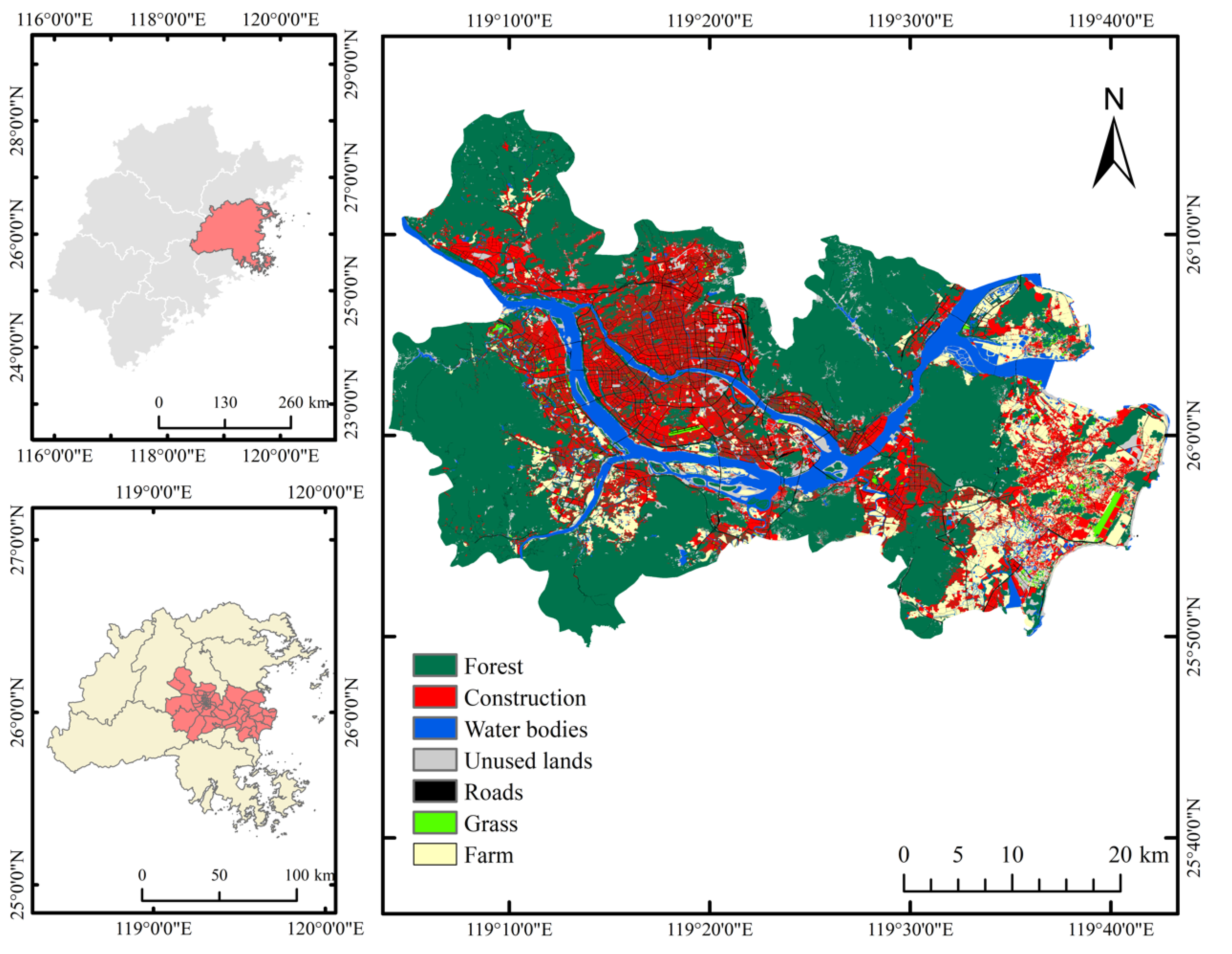

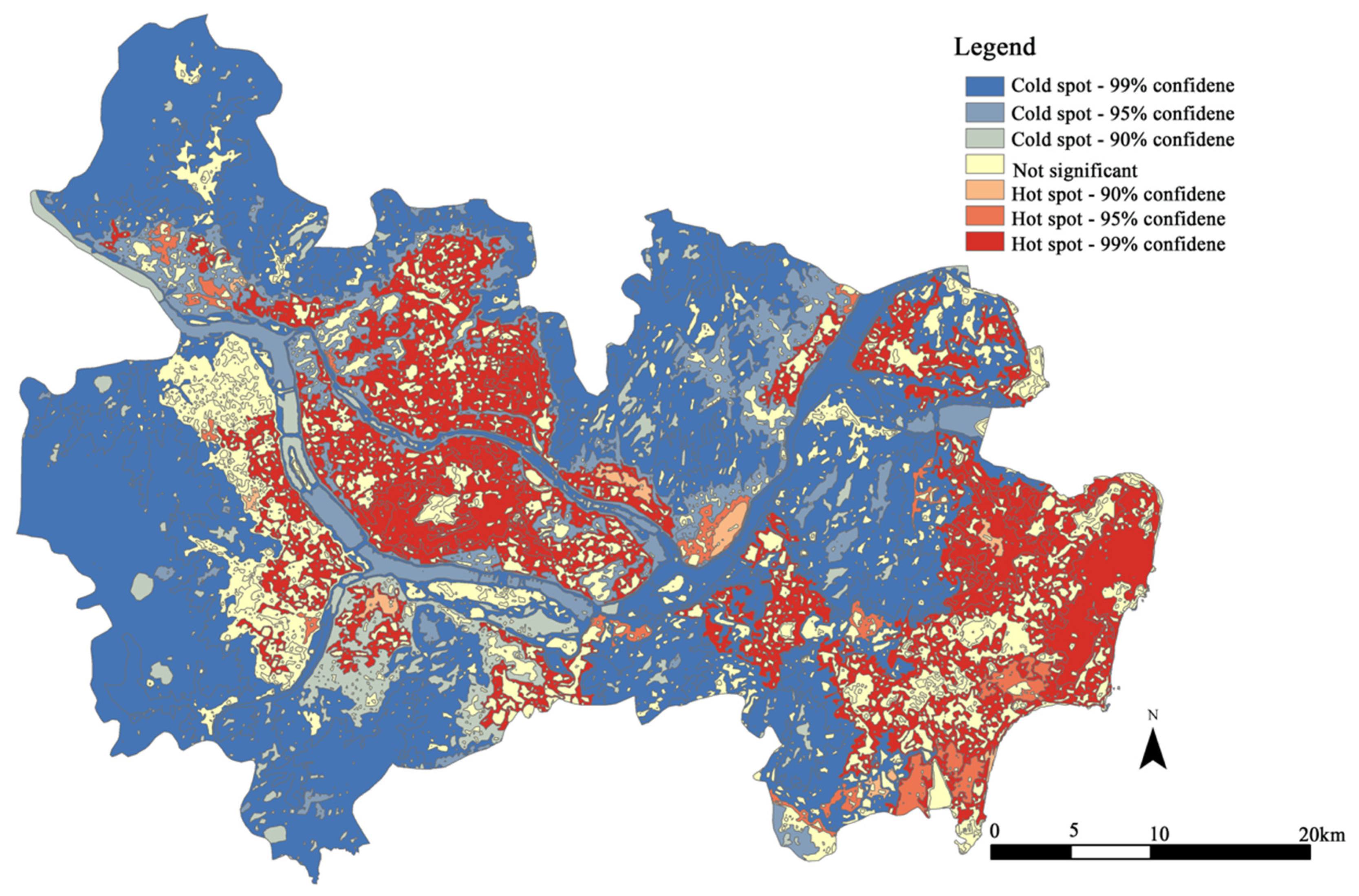

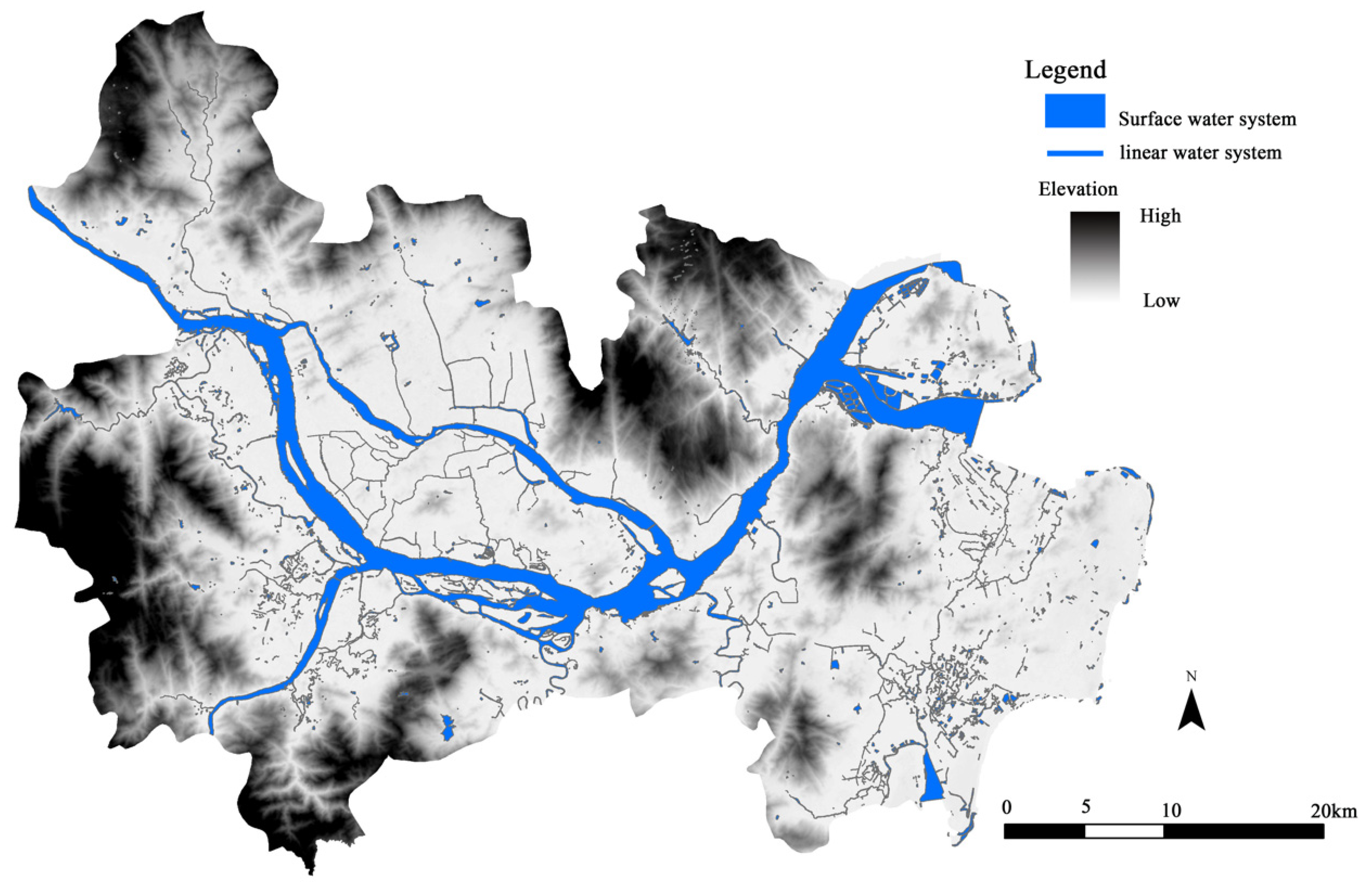

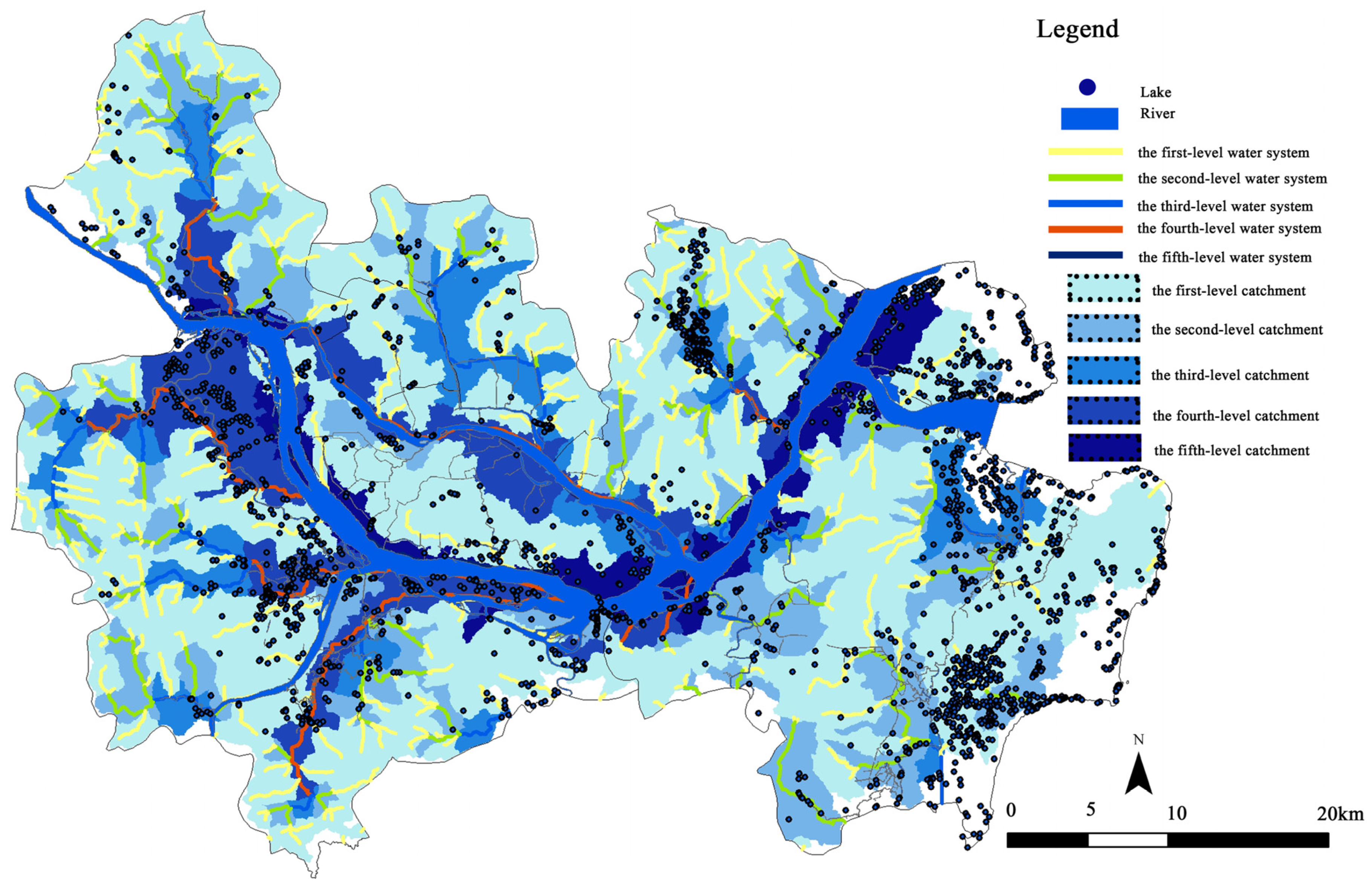

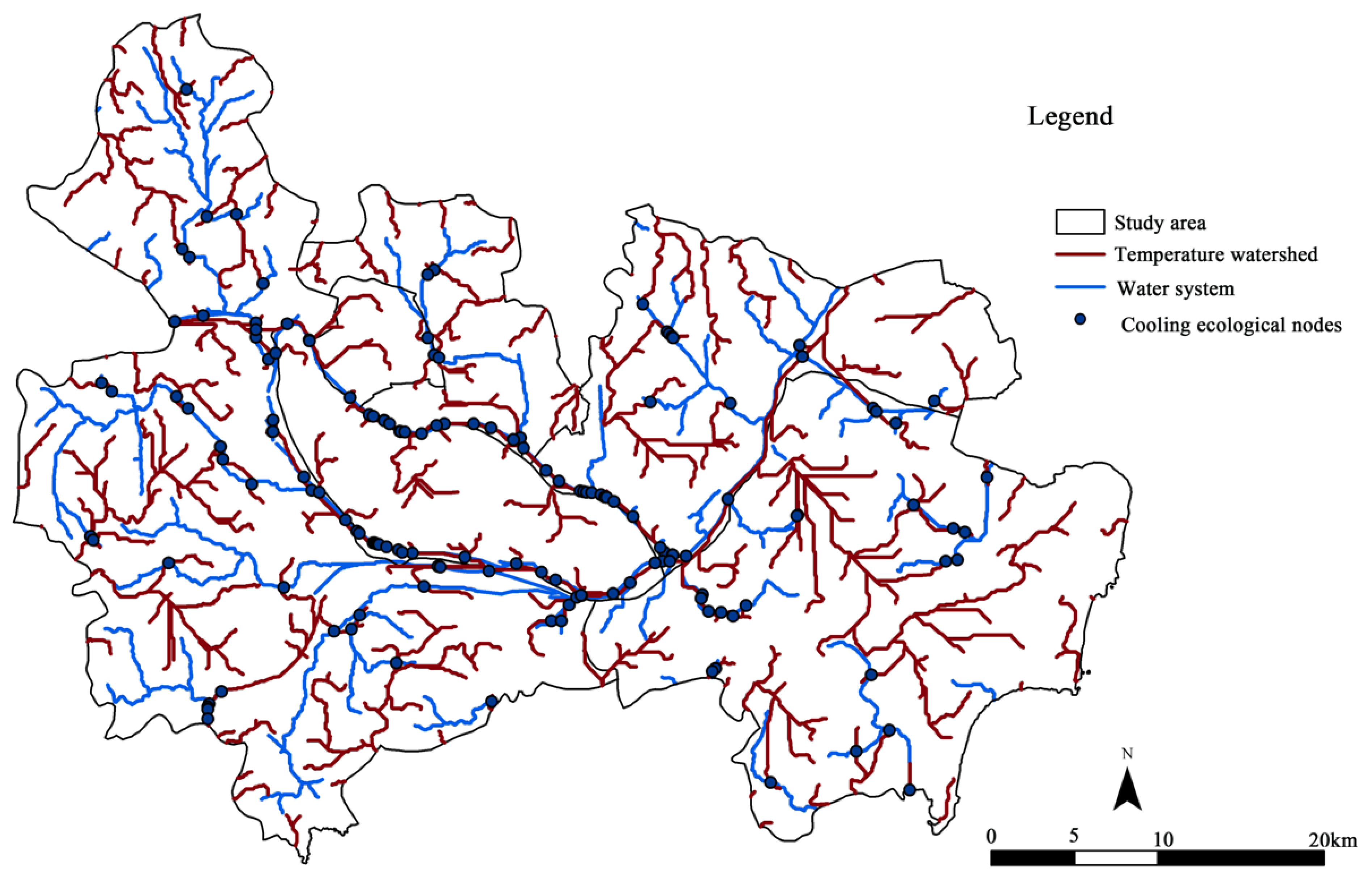

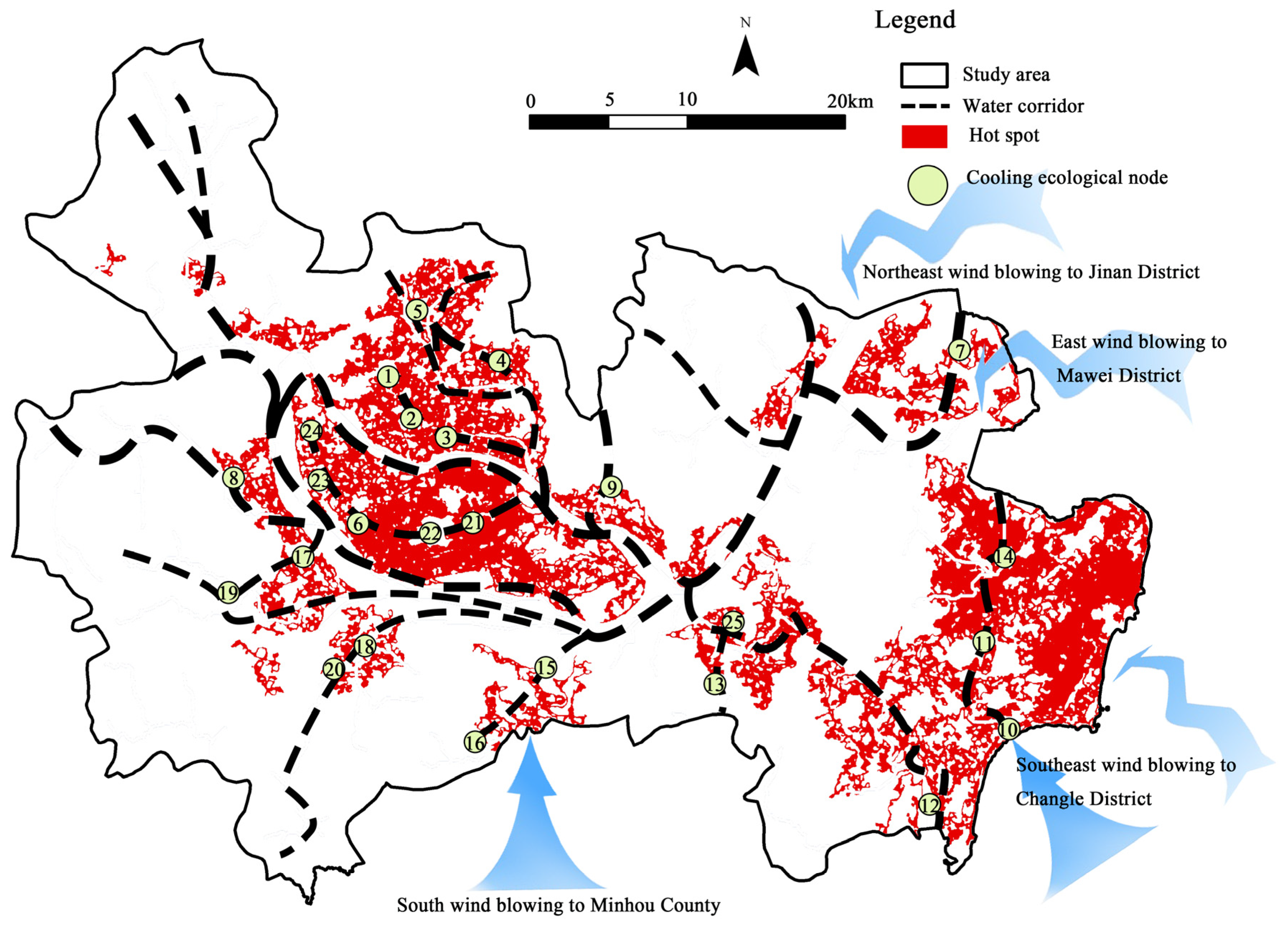
| Temperature Watershed Level | Administrative Regions (Unit: km2) | ||||||
|---|---|---|---|---|---|---|---|
| Cangshan | Gulou | Jin’an | Mawei | Minhou | Taijiang | Changle | |
| First-level | 50.71 | 16.93 | 48.47 | 92.90 | 322.19 | 10.01 | 201.10 |
| Second-level | 20.54 | 0 | 7.52 | 18.45 | 31.58 | 5.50 | 11.70 |
| Third-level | 0 | 0 | 0 | 15.70 | 0 | 0 | 18.70 |
| Fourth-level | 0 | 0 | 0 | 10.77 | 0 | 0 | 1.56 |
| Total | 71.25 | 16.93 | 55.99 | 137.82 | 353.77 | 15.51 | 233.06 |
| Water System Type | Administrative Regions (Unit: km2) | |||||||
|---|---|---|---|---|---|---|---|---|
| Cangshan | Gulou | Jin’an | Mawei | Minhou | Taijiang | Changle | total | |
| Linear water system area | 21.86 | 0.99 | 1.33 | 27.05 | 51.19 | 3.41 | 24.09 | 129.92 |
| Surface water system area | 0.89 | 0.39 | 0.63 | 6.96 | 6.33 | 0.01 | 12.85 | 28.06 |
| Total | 22.75 | 1.38 | 1.96 | 34.01 | 57.52 | 3.42 | 36.94 | 157.98 |
| Administrative Regions | Area (Unit:km2) | |||||
|---|---|---|---|---|---|---|
| First-Level Catchment | Second-Level Catchment | Third-Level Catchment | Fourth-Level Catchment | Fifth-Level Catchment | Total | |
| Jin’an | 64.74 | 13.42 | 28.05 | 1.73 | 0 | 107.94 |
| Taijiang | 9.14 | 0.22 | 1.15 | 7.97 | 0 | 18.48 |
| Cangshan | 70.26 | 8.25 | 9.68 | 27.81 | 31.29 | 147.29 |
| Gulou | 20.68 | 3.01 | 5.28 | 8.31 | 0 | 37.28 |
| Mawei | 125.66 | 41.5 | 15.65 | 13.49 | 38.53 | 234.83 |
| Minhou | 332.79 | 124.06 | 54.4 | 120.9 | 28.81 | 660.96 |
| Changle | 218.61 | 123.7 | 30.66 | 6.53 | 27.36 | 406.86 |
| Administrative Regions | Cooling Ecological Nodes | |
|---|---|---|
| Number | District Location (No.) | |
| Gulou | 2 | Xihu Park (1), Liminghu Park (2); |
| Taijiang | 1 | Jin’an River and Guangming Port Intersection Area (3); |
| Jin’an | 2 | Helin Ecological Park (4), Qintinghu Park (5); |
| Cangshan | 5 | Feifeng Mountain Olympic Theme Park (6), Baihuting(21), Gao Gai Mountain Park (22), Jinshan Park (23), Zhenban Village Mountain (24); |
| Mawei | 2 | Langqi Xingfu Reservoir (7), Moxi Scenic Area (9); |
| Changle | 6 | Changle mussel Park (10), Caizhai Village (11), Wenwusha Reservoir (12), Yutian Town (13,) Wenling Village (14), Chang’an Park (25); |
| Minhou | 7 | Tajiaozhou Wetland Park (15), Shigu Mountain (16), Xiyuanjiangkou (17), Zeyang Village (18), Qishan Qipangshi Scenic Area (19), Dazhangxi Nantong Shangzhou Park (20), Qi’an Village (8). |
| Administrative Regions | Path Type | Newly Generated Corridor Paths |
|---|---|---|
| Gulou | Tandem | 1—Baima River Park—2—3—Minjiang River and other waterways along the way; |
| Taijiang | ||
| Jin’an | Tandem | 5—North Area—Xindian Creek—4—Guangming Port—Aofeng Zone—Minjiang River and other waterways along the way; |
| Cangshan | Tandem | 21—22—6—Jinshan residential Area—23—Jinshan Industrial Zone—24; |
| Mawei | Tandem Optimization | (1) Minjiangkou–Longtai Village—7—Wuzhuang Village along the water system; (2) Minjiang—Moxi—Kuiqi residential area—9; |
| Changle | Tandem Tandem Tandem | (1) 10—11—14—estuary (11—14 there is a break in the flow); (2) 12—Changle Lianhua Mountain—25—Minjiang River (12—25 there is a break in the flow); (3) 13—25—Minjiang River (13—25 there is a break in the flow); |
| Minhou | Tandem Tandem Optimization Optimization | (1) Wulong River—15—Taojiang River—Shenhai Expressway—16(15—16 there is a break in the flow); (2) 19—17—Wulong River; (3) 8—Xiyuan River—Shangjie University Area—Wulong River (optimized on the basis of the original); (4) 20—18—Wengong River—Wulong River (optimized on the basis of the original); |
Disclaimer/Publisher’s Note: The statements, opinions and data contained in all publications are solely those of the individual author(s) and contributor(s) and not of MDPI and/or the editor(s). MDPI and/or the editor(s) disclaim responsibility for any injury to people or property resulting from any ideas, methods, instructions or products referred to in the content. |
© 2023 by the authors. Licensee MDPI, Basel, Switzerland. This article is an open access article distributed under the terms and conditions of the Creative Commons Attribution (CC BY) license (https://creativecommons.org/licenses/by/4.0/).
Share and Cite
Lin, J.; Yang, W.; Yu, K.; Geng, J.; Liu, J. Construction of Water Corridors for Mitigation of Urban Heat Island Effect. Land 2023, 12, 308. https://doi.org/10.3390/land12020308
Lin J, Yang W, Yu K, Geng J, Liu J. Construction of Water Corridors for Mitigation of Urban Heat Island Effect. Land. 2023; 12(2):308. https://doi.org/10.3390/land12020308
Chicago/Turabian StyleLin, Jiqing, Wufa Yang, Kunyong Yu, Jianwei Geng, and Jian Liu. 2023. "Construction of Water Corridors for Mitigation of Urban Heat Island Effect" Land 12, no. 2: 308. https://doi.org/10.3390/land12020308
APA StyleLin, J., Yang, W., Yu, K., Geng, J., & Liu, J. (2023). Construction of Water Corridors for Mitigation of Urban Heat Island Effect. Land, 12(2), 308. https://doi.org/10.3390/land12020308






